
Andrew Bostock, The Guardian, June 03, 2015
The Dodecanese translates as “the twelve islands”, of which the most well-known to the British traveller are the green expanses of Rhodes and Kos. Those who know their biblical history will have heard of Patmos, where St John wrote his Book of Revelation. In recent years canny visitors have been heading for lesser-known islands. Karpathos, the third biggest of the chain, has a stunning coastline divided between the beaches and bays of the south, and the rough crags of the north. Smaller Kalymnos, Kasos, Kastellorizo and Symi are less lush than their bigger companions but all have elegant harbours – a legacy of their trading past – and rocky interiors that offer good walking.
Nisyros, built on a still-active volcano, is a different story, and its dramatic, blackened, landscapes will please geology lovers. Astypalea, on its own to the west of the other islands, feels more part of the Cyclades than the Dodecanese. The more benevolent landscape of Leros and the low-key, and little-visited, charms of Tilos bring the count of 12 to an end.
This is not the end of the Dodecanese, however. The chain includes 14 other, smaller, islands that are inhabited to some degree, as well as the normal countless rocks that boast a few goats and a beach. What binds them all is a common history, mainly due to their location. The coast of western Asia is less than 100 miles away and these strategically located rocks have been fought over for centuries – by the Crusaders, the Ottomans, the British and the Germans, among others. History has long swirled around these fascinating islands.
There has been recent press coverage reporting that Kos is being overrun by refugees from the Middle East. While it there is an issue, this has been exaggerated by parts of the British media.
Prices are for one week’s accommodation for two in August and include breakfast, unless stated. Prices outside of this month can be cheaper. Taverna prices stay remarkably similar, and if anything have gone down in recent years. You can expect to eat well for €15-€20pp. If eating places are cheaper/more expensive than this it is stated in the text
Rhodes Town
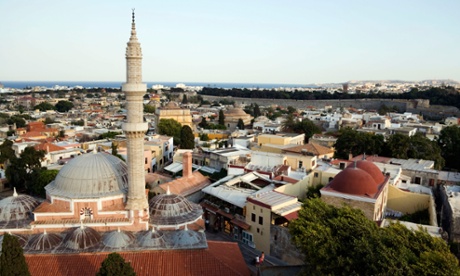
Rhodes Town skyline, including the mosque of Suleiman. Photograph: Alamy
Where to stay Spirit of the Knights
Undoubtedly the best place to stay within the medieval walled splendour of the old town. The hotel has six individually-styled suites, which are cleverly incorporated into a building originally built by the Crusaders on a quiet cobbled lane. Exquisite attention to detail, beautiful artwork from the wider region, and great service combine to make this a must.
• £1,000, +30 22410 39765, rhodesluxuryhotel.com
Where to eat Symi Kafeneion (no phone)
Eating in the old town can be expensive. To find something cheaper, and perhaps more authentic, go north to the market in the new town, where this family-run establishment has been specialising in meze since 1946. Try the roasted vegetables in garlic vinaigrette.
Don’t miss
The best thing to do in the old town is simply to lose yourself wandering its maze of alleys. In places it succumbs to over-commercialisation but this is still one of the finest medieval towns in Europe.
Lindos, northern Rhodes
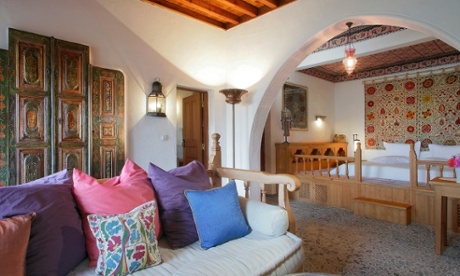
Accommodation at Melenos Lindos
Where to stay Melenos Lindos
There are plenty of places on this tourist-heavy island that you might want to avoid but when it gets it right it is still world-class. A case in point is this superb boutique hotel between the acropolis and bay of the medieval town of Lindos. Mosaic paths wind over terraces leading to beautiful rooms decorated with Moorish woodwork and featuring traditional platform beds. This kind of luxury doesn’t come cheap, but this is worth every penny.
• £1,540, +30 22440 32222, melenoslindos.com
Where to eat Broccolino
The rooftop terrace restaurant at the Menelos is a famous destination in its own right, but there are plenty of options down in town itself, although Lindos does tend to be on the expensive side. For something different to the usual taverna food try this Italian restaurant that serves excellent pasta and seafood.
• +30 2244 031688, Facebook page. Slightly expensive
Don’t miss
The acropolis above Lindos has a Crusader castle that contains much more than ancient ruins. Make the climb up (or have a lazy donkey ride) first thing in the morning to beat the crowds and get the stunning views to yourself.
Kos Town
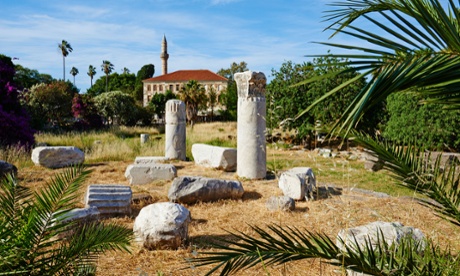
Agora, Kos Town. Photograph: Alamy
Where to stay Kosta Palace
Kos is the most fertile of the Dodecanese and has some of its best beaches. It has long been dominated by the package-holiday market and independent travellers tend to stick to Kos Town. A good option here is this harbourside hotel with a rooftop pool.
• £426, +30 22420 22855, kosta-palace.com
Where to eat Sardelles
Just around the corner from the Kosta Palace, where Averof Street meets the beach, is this friendly and very reasonable seafood taverna. The steamed mussels are excellent.
• +30 22420 26099
Don’t miss
Kos Town, with its inevitable Crusader castle, remains a delight to wander around, although it can get crowded. A more authentic version of Kos can be seen when visiting the mountain village of Asfendiou, just to the west of town, but be aware that package companies sometimes run excursions here.
Mandraki, Nisyros
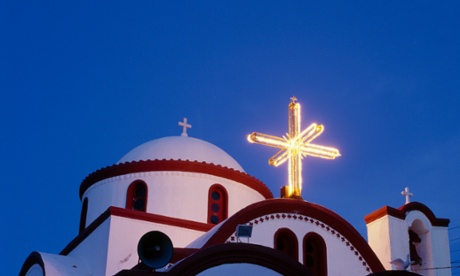
Low angle view of a church in Mandraki. Photograph: /James May/SuperStock/Corbis
Where to stay Ta Liotridia
In Mandraki, the main town of Nisyros, the waves beat right up against the volcanic stone buildings. One of these is this music cafe that has two lovely suites upstairs, with traditional furnishings and views to the water below.
• £400, +30 22420 31580, nisyros-taliotridia.com
Where to eat To Kazanario
On a small alley, just off the seafront, this is an old-fashioned ouzeri, which means the emphasis is on seafood meze, including that rarity, perfectly fried and tender kalamari. There is indoor seating and archways that lead into a garden overlooking the locals’ vegetable patches. It’s also a good place to catch impromptu music sessions.
• +30 69722 40556
Don’t miss
There’s some great and superbly dramatic hiking on Nisyros, most of it based around the central caldera of the volcano. This can most easily be reached from the villages of Emborios and Nikia, both of which have stunning views out to sea and down into the volcano.
Pserimos
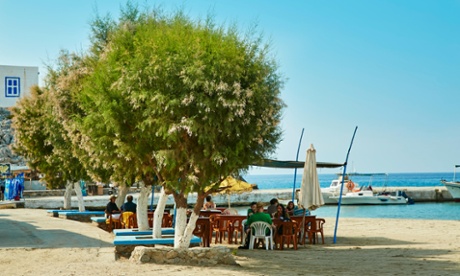
Pserimos village. Photograph: Alamy
Where to stay Kalliston Studios
With a permanent population of just over 20, and blessed with remote, sandy beaches, Pserimos should be an island paradise. Unfortunately, it attracts excursions from nearby Kos and Kalymnos that mar the seclusion. The trick, then, is to stay here as when the boats have gone you have the place almost to yourself. These studios offer simple but perfectly adequate accommodation.
• £150, no breakfast, some studios are self-catering, +30 69803 89276
Where to eat Sevasti Pikou
Most tavernas and cafes here cater to the excursion crowd. This place is more local and serves freshly-caught fish, as well as delicious vine leaves stuffed with rice, meat and tomato.
• +30 22430 29337
Don’t miss
The beaches. When the tour boats are around there is some nice hiking to be done, and most of the tourists don’t make it past the most obvious patches of sand. The best of the bunch is perhaps Grafiotissa, with its sandy beach overlooked by a ruined church.
Tilos
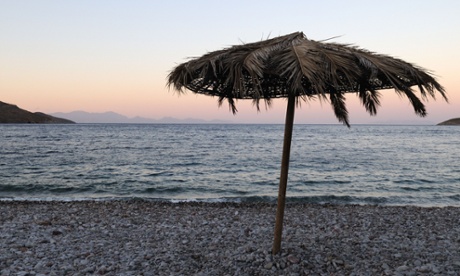
The beach at Tilos. Photograph: Alamy
Where to stay Eristos Beach
Camping outside of an official campsite in Greece is officially illegal but often tolerated, especially away from other accommodation. This is the case at Ersitos, where a mini village of tents and palm frond-shaded shelters pops up each summer; some visitors have been returning for over 20 years. The beach itself is a kilometre of sand that often has a pinkish tinge from the surrounding reef.
• Free
Where to eat Kali Kardia
The nearest bit of civilisation is the inland capital of Tilos, Megalo Horio. There are only two tavernas here, but fortunately both are excellent. The Kali Kardia is a great place to hang out with the locals.
• no phone
Don’t miss
If you can tear yourself away from the sand, Megalo Horio is well worth a visit, not least for the food (see above). Unusually for the Dodecanese, this island capital has retained its traditional character. A stiff walk takes you up to the acropolis that towers above the town. Obviously there is a Crusader castle at the top to entice you, as well as great views.
Symi Town
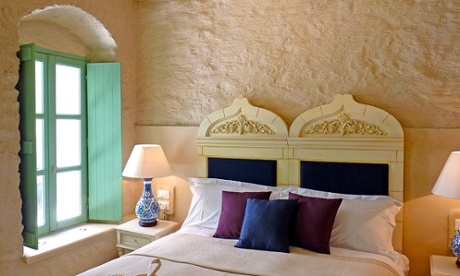
The Old Markets, Symi
Where to stay The Old Markets
It’s not often you get to stay in a registered national monument. The Old Markets used to be the heart of the spice, silver and sponge trade on Symi. Unfortunately, it was bombed in 1944 but Andrew, from England and Carlo, his Italian partner, have restored it into a gem of a place. History pervades, but it is married to an understated sense of luxury.
• £1,110, +30 22460 71440, theoldmarkets.com
Where to eat Tholos
A little bit away from the busy front of Symi Town but still right by the sea, is this tavern, with tables right by the water. Grilled fish is the speciality.
• +30 22460 72033
Don’t miss
Symi Town, arrayed around a stunning natural harbour, is perhaps the finest port town in the Dodecanese; because of this it is always popular and buzzing. If you need to get away from the action leave the lower town behind and climb the long stair path to Horio, the old town, topped by a castle.
Leros
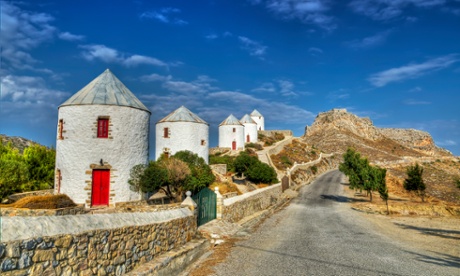
Photograph: George Papapostolou/Getty Images/Flickr Open
Where to stay Archontiko Angelou
This grand Italianate mansion has nine different rooms with antique furnishings. It is a short stroll to the best beach on this quiet and pretty little island. As you explore look out for the old upcycled shell cases that are left over from the German paratrooper invasion of the island in 1943.
• £430, breakfast €12, +30 22470 22749, hotel-angelou-leros.com
Where to eat To Fanari
A five-minute walk takes you into Alinda, where there is a short string of beachside tavernas. To Fanari, a family-run business, is the most authentic of the lot and does Greek standards to a good quality at a good price.
• +30 69841 35216
Don’t miss
You can scuba dive at a couple of locations of Leros, and get lessons if you need them. The main attraction is to dive on the wrecks left over from the second world war.
Astypalea
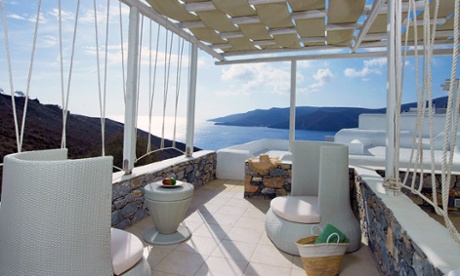
The Pylaia, Astypalea
Where to stay Pylaia
The charming village of Hora, with its whitewash buildings and windmills, is a slice of the nearby Cycladic islands. The Pylaia, just outside the village on a rocky outcrop, continues the theme with the kind of trendy, boutique chic you’d expect to find in Mykonos. The difference here is that the Astyplaea is relatively undiscovered and comes without the crowds.
• £850, +30 22430 61070, pylaiahotel.gr
Where to eat Barbarossa
The Pylaia has its own up-market, restaurant but Hora has a few standard tavernas. This one has a nice terrace and does good meat-based stews.
• +30 22430 61577
Don’t miss
The castle in Hora, in another departure from the norm in the Dodecanese, was built not by Crusaders but by the Venetians. It is one of the best examples of its kind and is reached through a maze of pathways.
Kastellorizo
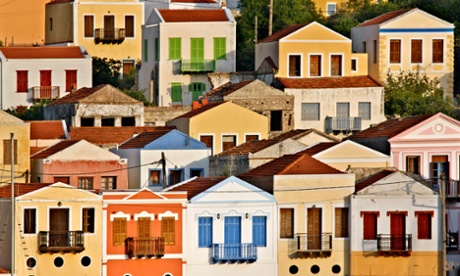
Photograph: Alamy
Where to stay Karnayo
Don’t come to the little island of Kastellorizo if you value your privacy. It is close to the coast of Turkey and the little Greek enclave is proud of its identity and so the locals are very friendly. After a short stroll down the pretty waterfront you will know half the population. These simple studios and rooms are in a well-restored building.
• £350, +30 22460 49266, karnayo.gr
Where to eat Olive Garden restaurant
Monika and Damien, who run this harbour-front restaurant, have a Greek, Australian and German background, and this is reflected in the eclectic menu. Excellent if unusual salads are combined with meat from the barbecue.
• No phone
Don’t miss
Take a boat trip to the crystal-clear sea of Navlakas fjord, which has excellent snorkelling and the shimmering blue waters of Perasta cave.
Getting there
In summer easyJet and Ryanair fly direct to Rhodes and Kos from the UK, with prices starting at around £50 each way if you book early. Pserimos is reached by ferry or excursion boats from Kos or Kalymnos. Nisyros, Tilos and Symi are reachable on scheduled ferries from Rhodes and Kos. Leros and Astipalea are reachable by ferry but also have flights from Athens and some of other of the large islands. Kastellorizo has daily flight from Rhodes, as well as the usual ferries.
This article originally appeared on guardian.co.uk
This article was written by Andrew Bostock from The Guardian and was legally licensed through the NewsCred publisher network.
![]()